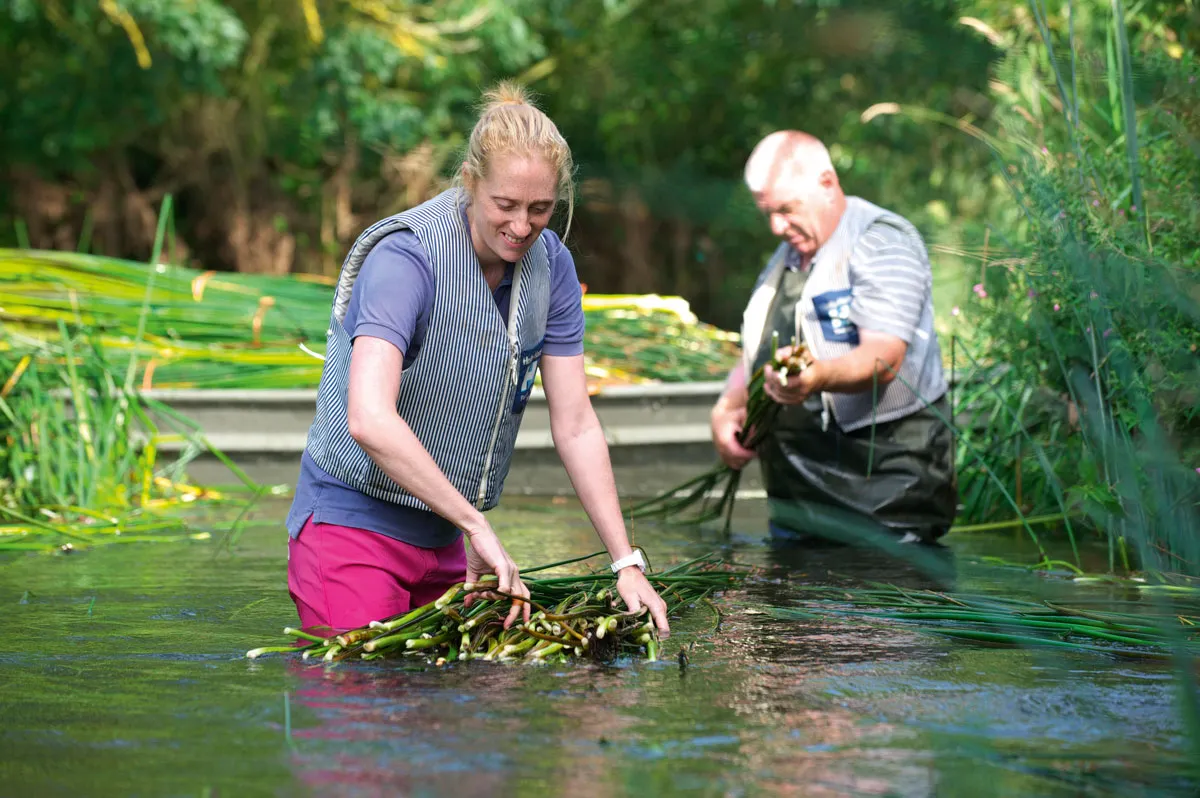Paddling a kayak upstream on the beautiful River Waveney is a pleasant experience. The morning sunshine glitters on
the water, cows munch on fresh grass at the water’s edge, and the air is filled with birdsong, butterflies, the hum of insects and the occasional splash of a surfacing fish.
The current is surprisingly strong, but after 15 minutes of tough paddling, the rush cutters come into view. They stand waist-deep in clear water, pulling, cutting and tying armfuls of lush green bulrushes.
One cutter gathers these bunches and pushes them downriver to the next, who trims, ties and forms a bolt, or bundle. A third loads on to a metal barge.
The team have been hard at work for weeks now, clearing this stretch of river, gradually moving deeper into the heart of the countryside.
One of the cutters is Anna Truman, manager of Waveney Rush, a small company that weaves rushes into traditional baskets and matting at its waterside workshop, on the edge of Oulton Broad. She says the company is keen to gather more rushes from the Broads on their doorstep; but she admits that the harvest has been hard work.
“A lot of the rush we’re cutting and clearing is simply too old for our high standards,” she explains. Age make the rushes congested, stringy – and much tougher to harvest. “But you have to start somewhere, and it’s good to make that
start in our home county.” The regrowth, when it comes, will be more tender and easier to harvest.
With every swipe of the slim scythe and pull of the bulrush, the clearing of another cluttered path of river is complete. The clearance makes way for a torrent of water gushing towards the cutters, pulling the odd section of untied rush down river. It also makes the river navigable to small vessels once more. “Canoeists had been complaining that this stretch of the Broads was becoming impassable,” says Anna.

Speedy rush
A few days later, I visit the Waveney Rush workshop, which is in the loft of an old maltings with beautiful views of Oulton Broad. Here, beneath wooden beams, the weavers practice their ancient craft. Among them is Millie, the workshop manager,
who has been involved with the industry for 25 years. Holding a 20-yard length of weave, she works at incredible speed, pushing the dried rush through and over, twisting and then pulling tight. “You know within a day whether you’ll like this work, and if you’re any good,” she laughs.

There are new faces at the company, too. Gemma joined straight from college and progressed well, learning nine-ply and three-ply weave techniques before moving on to basket-making. “It’s not the best paid or the most glamorous job, becoming a weaver. You need a passion and desire,” says Anna. “Thankfully, Gemma has both. It has been great to have her involved in our weaving.”
The weave that Millie is currently working is being prepared for a new mat, which is being shipped to America. The three-inch wide weave will reach a length of 24 yards, a typical day’s work for one of the weavers.
Waterway to weave
The rushes Millie is weaving are a subtle golden colour, unrecognisable from those cut a few days before on the river.
When the cutters return with their harvest, they lay the rushes, still tied in bolts, out in the open air, exposed to the sun and wind. This drying process typically reduces their weight by a fifth.
After a few days, the rushes are gathered and kept in a barn. By now some have turned a honey colour; others remain a mellow green. When the weaver is ready, she selects her rushes. After soaking them in a tank of water for hours to make them more flexible, she feeds the rushes through a mangle. This squeezes moisture from the rush and crushes its spine, filling the workshop with a distinctive crackling noise. The rushes are now soft and supple.
Costly craft
Upstairs in the loft, Millie and Julie begin interlocking the rush, using the nine-ply method. They are are making a large, 2.5m x 1.5m (8ft x 5ft) mat for a regular client. With a needle and thread, the weavers kneel, working left to right, carefully threading
the natural twine through to bind the mat. It will take days to finish. “The main cost is labour,” says Anna. “You want to keep it English, maintaining the craft and expertise, as that is what it is all about. But that takes time and costs money.”
Millie’s next project is to repair some rush matting from a National Trust property, part of which has been worn away by the footfalls of thousands of visitors. She explains that she will cut away the worn area and sew freshly woven sections in place. In time, she explains, rush can become dry, and turn brittle, so that small fragments break off. Woven rush, says Millie, is “a living product” – and needs to be nourished with a little moisture. “It’s important to keep the rushes alive and healthy, so we recommend spraying a light mist of water onto the surface every four to six weeks.” The finished product may last up to 20 years, naturally depending on conditions and wear, says Millie.
Despite the efforts to gather local rushes, most of those used by the weavers are imported from the Netherlands. “We would love to source rushes locally, of course we would, and certainly the grant to start cutting on the Southern Broads has helped start things off. The harvest took a lot longer than we anticipated, but now that we’ve started the process, hopefully the harvest will prove sustainable and we’ll be able to use Suffolk bulrush full time.”
Julian Claxton is a photographer who lives in Suffolk and enjoys travel, adventures and the great outdoors.
